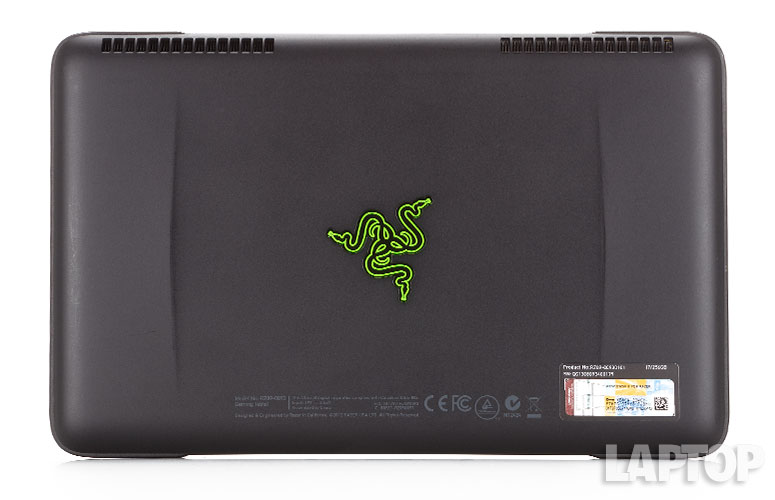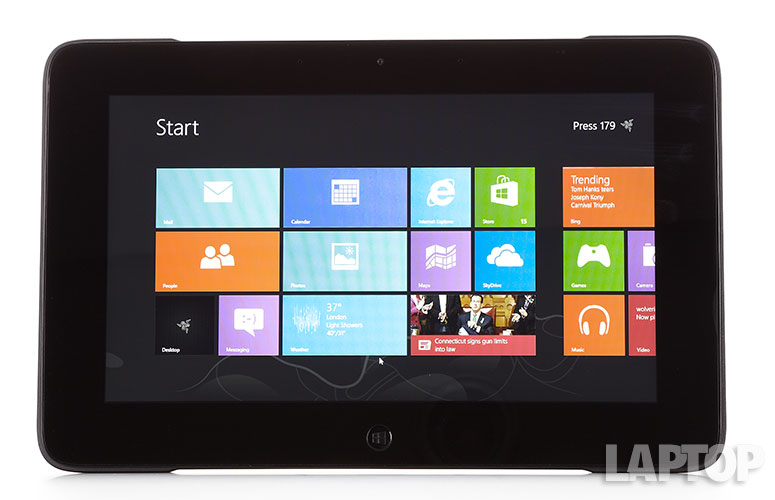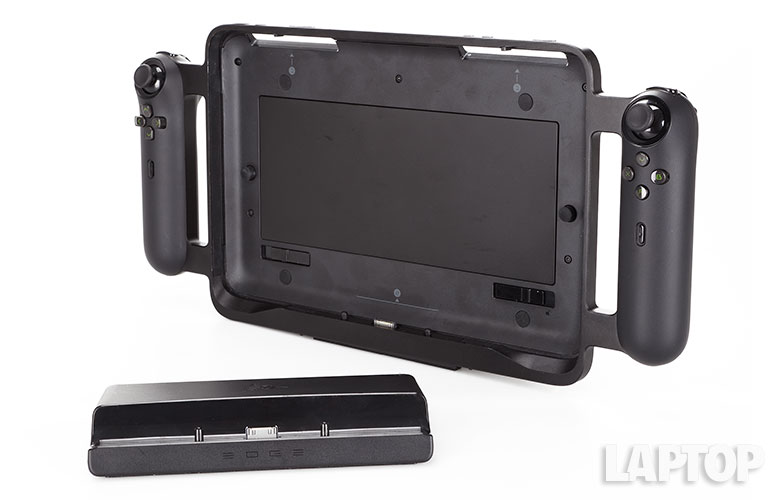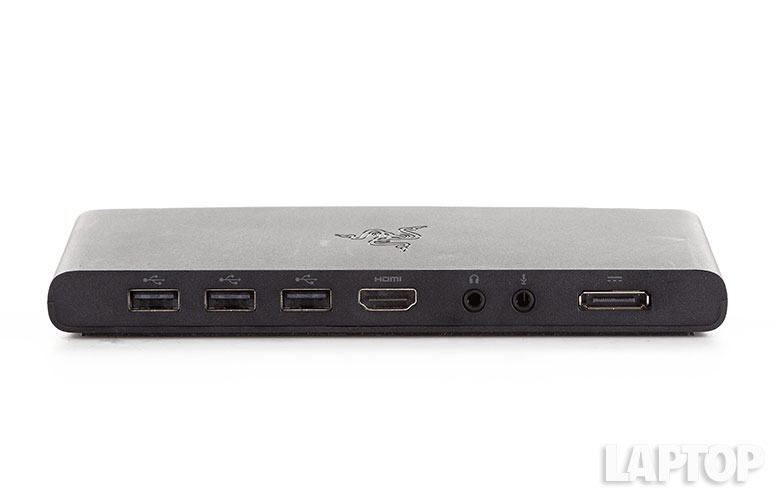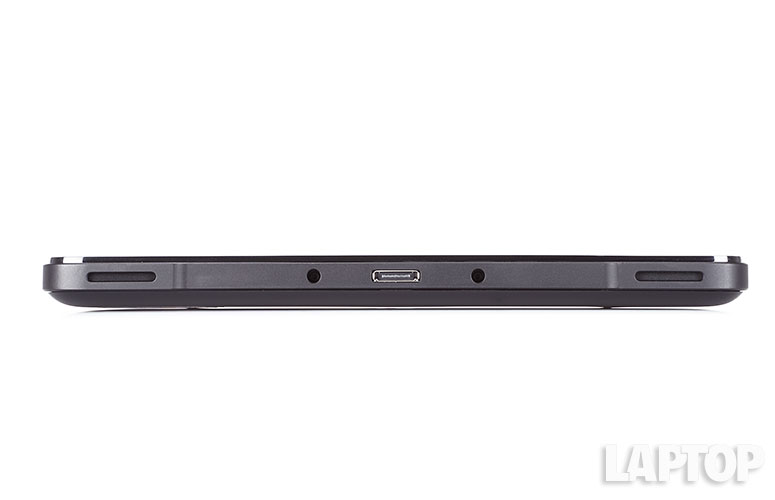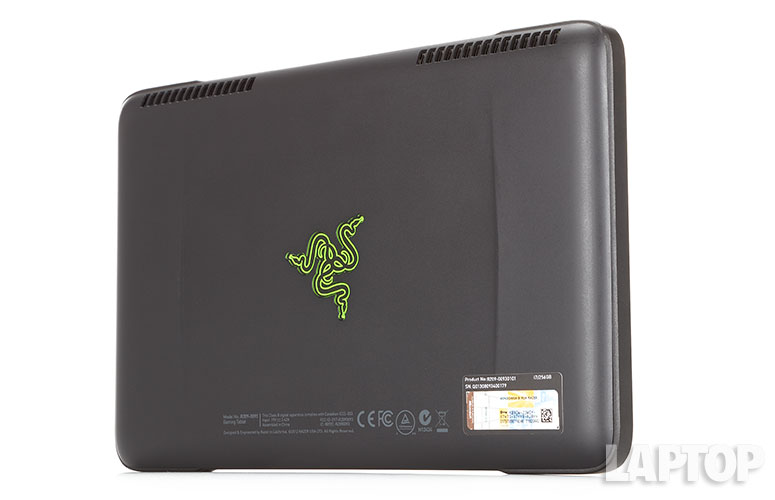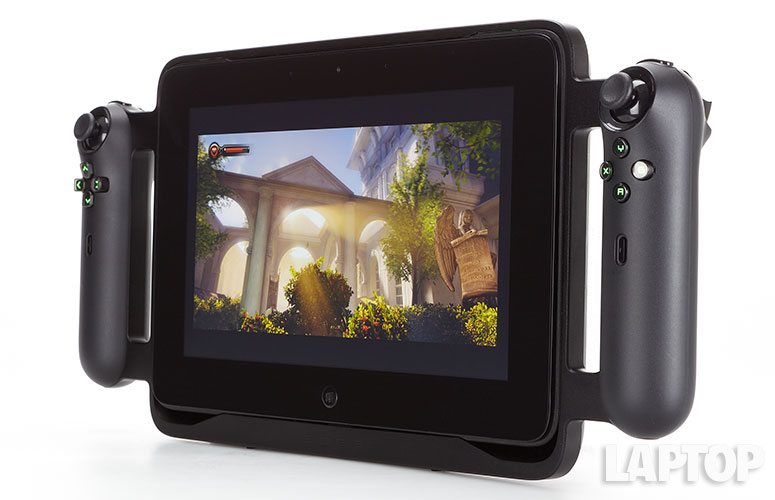Laptop Mag Verdict
The Razer Edge Pro gaming tablet crams high-powered specs into a chunky chassis for fragging on the go.
Pros
- +
Excellent graphics power and overall performance
- +
Stylish design
- +
Innovative Gamepad peripheral
- +
Docking station brings console-gaming feel to PC
Cons
- -
Expensive
- -
Short battery life when gaming
- -
Gamepad makes design bulky
- -
Display not 1080p
- -
Runs hot when gaming
Why you can trust Laptop Mag
PC gaming just got decidedly more mobile. Billed as the world's most powerful tablet, the new Razer Edge Pro comes with an Intel Core i7 processor and Nvidia GeForce graphics, which can handle even demanding games like BioShock Infinite. And if the high-powered specs aren't enough, the tablet also has three optional peripherals allowing for three styles of gameplay. However, the $1,449 price will be a big obstacle for gamers eager to take Edge Pro for a spin. Read on to discover if this cutting-edge Razer is a killer gaming tablet or just a curiosity.
[sc:video id="ZjdnA1cTrp1IZEN_6SeIiHBBcgE5_OP5" width="575" height="398"]
Design
Click to EnlargeWe couldn't fault you for calling the Razer Edge Pro a mini Razer Blade.
Although it's made of plastic rather than aluminum, the rear panel of the tablet sports a design similar to the lid of the Razer Blade notebook. But a plastic chassis doesn't diminish the Edge Pro's sex appeal, as we continually found ourselves running our fingers over its slight ridges. We also found the green, glowing Razer insignia mesmerizing.
Click to EnlargeThe Pro's sides are made from aluminum, most likely intended to protect against inevitable drops. A pair of vents along the top kept things cool while the panel successfully rebuffed our fingerprints and smudges. A rear-facing camera is conspicuously absent.
Click to EnlargeThe 10.1-inch glossy display is surrounded by an equally glossy and thick 1-inch black bezel. A 2-MP camera is centered along the top with a black physical home button on the bottom. The display juts 0.25-inches out of its casing.
Sign up to receive The Snapshot, a free special dispatch from Laptop Mag, in your inbox.
There's a USB 3.0 port, an audio jack and a glossy black volume rocker along the top right corner of the tablet. The left top corner of the Edge Pro holds buttons for power, auto-rotation and the keyboard. A proprietary charging port sits at the bottom of the tablet along with docking slots and a pair of speakers.
Razer crammed a lot of high-powered specs into the Edge Pro. The result is that this 2.2-lbs., 10.9 x 7.0 x 0.76-inch device has a little more junk in its trunk than the average Windows 8 slate. By comparison, the Microsoft Surface Pro and Samsung ATIV Smart PC Pro 700t, both of which have larger 11.6-inch displays, weigh 2 lbs. and measure 10.8 x 6.8 x 0.53 inches and 11.9 x 7.46 x 0.47 inches, respectively.
MORE: 10 Most Anticipated PC Games of 2013
Gamepad
Click to EnlargeBack when the Edge Pro was Project Fiona, the tablet had two large handlebar controllers permanently mounted on either side. Razer made the wise decision to turn this setup into an optional, removable peripheral. However, the gamepad is priced at $249, a steep investment for a tablet starting at $999.
The pad consists of two cylindrical controllers bolted to a shell large enough to accommodate the Edge Pro. The gamepad has cutouts for the tablet's vents, USB 3.0 and headphone jack. There are also corresponding buttons for volume, power, keyboard and auto-rotate. A charging port and a pair of docking tines sit at the bottom of the dock and are part of a larger locking mechanism that deploys via a pair of latches. The pad also houses the tablet's extended battery, which Razer claims will add 8 hours of battery life to the Edge Pro.
Click to EnlargeSlipping the tablet in and out of the gamepad can be a little tricky. First, we had to unfasten the latches at the bottom of the pad, deploying a small panel. The tablet must be placed into the pad top-first then gently pushed into place. From there, a quick press of the exposed panel at the bottom of the peripheral locks the tablet securely in place. To remove the Pro, we unfastened the dock latches and used our finger in one of the bottom depressions to dislodge the tablet from the pad.
The Pro splits the traditional Xbox controller setup between the handlebars. The left stick holds the D-pad, a back button, left trigger and bumpers for L1 and L2. The face and select buttons sit on the right handlebar along with a right trigger and R1 and R2 buttons. Each controller has its own analog stick, with the left controlling movement and the right adjusting the camera.
The D-pad and face buttons are well spaced, but a bit on the small side. They're also mushier than we would prefer, considering how buttons tend to lose their springiness over time. The bumpers and the rear triggers, however, delivered firm feedback.
When it came to actual gameplay, the pad held up to our frantic button mashing. One of the pain points was that the analog sticks were looser than we'd prefer. This made it somewhat difficult to line up shots in "BioShock Infinite."
The weightier problem stemmed from the Edge Pro's bulk. The gamepad/tablet combo is strictly a lap affair. Weighing a combined 4.2 lbs., we could only hold the tablet at face level for 3 to 4 minutes at a time before our arms tired.
Docking Stations
Click to EnlargeFor those instances when you want to take your gaming to the big screen, Razer created a docking station that gives you that home-console feel. Priced at $99.99, the 0.8-lbs., 6.75 x 3.25 x 0.6~0.8-inch station is made of black matte plastic with Razer's three-headed snake logo displayed prominently on the front. Docking tines flank the charging port on either side. The rear of the port features three USB 2.0 ports, HDMI, audio in, audio out and the charging port.
Click to EnlargeUsing the dock is pretty straightforward. After placing the Edge Pro onto the dock, we plugged in a controller and connected the dock to our Samsung Series 8000 TV via HDMI. From there, the dock recognized the television as the primary display, eliminating the need to adjust the resolution on the Edge Pro.
We launched "BioShock Infinite" using Razer Launcher, a pre-installed program that mimics a home-console user interface. We adjusted the resolution to 1920 x 1080 and started taking down Patriots and Firemen on the beautiful, 55-inch display. As we prepared to chuck a fireball into a hostile crowd, the flaming projectile bathed our fingers in flickers of red and yellow. Details were sharp enough to display the minute details of the in-game currency.
We only experienced lag when we cranked up the graphics quality.
Razer will offer a keyboard dock sometime in Q3 for more traditional PC gaming. Pricing has yet to be revealed. We were disappointed that the keyboard isn't shipping during the initial launch since some games require an old-school mouse and keyboard setup. The lack of a keyboard also makes most productivity tasks very difficult to complete.
MORE: 5 Multibutton MMO Mice for Hardcore Gamers
Razer Launcher
Click to EnlargeRazer's pre-loaded software attempts to deliver a console experience a la Xbox Live or PlayStation Network. Set against a scaly, green background, the Launcher displays recently played games along with icons of available programs. We added games and programs using the + icon in the Launcher navigation bar. Here, gamers can also boost the Edge's performance in the Settings menu, update their Razer profiles and create shortcuts for their favorite games.
We had no problems navigating the simple, but clean Launcher UI with the gamepad. However, we ran into some pesky pop-ups from Steam, and there were a few instances when Launcher quit unexpectedly.
Display
Click to EnlargeThe Edge Pro's 1366 x 768p IPS display, which supports 5-finger touch, provided vivid color and sharp details. However, it would have been nice to see a 1080p screen, as on the Surface Pro and the Samsung ATIV Pro 700t. This is a pretty pricey tablet for not having full HD.
Our first glimpse of the airborne city of Columbia in "BioShock Infinite" revealed clear blue skies and neatly manicured gardens filled with bright red roses. Character models were detailed enough to show us the char on some unfortunate guards that we hit with the Devil's Kiss Vigor.
On the 1080p trailer of "The Wolverine," a katana-wielding warrior's bright-red mane popped against a clear blue sky. However, we noticed some pixelation during darker scenes. The tablet has solid viewing angles, but the reflective, glossy display proved distracting at times.
Measuring 390 lux, the Edge Pro's screen is brighter than the 371 tablet-average and the Samsung ATIV Smart PC Pro 700t's score of 329 lux. The Microsoft Surface Pro's display was slightly brighter at 394 lux.
Audio
Click to EnlargeThe Edge Pro's bottom-mounted speakers delivered loud and mostly clear audio with the help of the Dolby Home Theater v4 software. Booker DeWitt's speaking parts during "BioShock Infinite" lacked some of the gritty gravitas we heard on notebooks such as the Lenovo IdeaPad Y500. However, smaller details, such as the sharp click of Elizabeth's shoes across the marble flooring and the gentle hisses on the phonograph, were front and center.
When we listened to Adele's "Rolling in the Deep," the audio sounded hollow, particularly in the main vocals. The bass was present, but rather weak.
Heat
After watching 15 minutes of "Archer" on full screen on Netflix, the sides of the Edge Pro's rear panel measured 90 degrees Fahrenheit. The glowing logo and right vent measured 100 degrees, while the left vent blew a cool 82 degrees. We consider anything above 95 degrees uncomfortable.
When we started playing "BioShock Infinite," the left vent measured 89 degrees. The logo on the back rose to 116 degrees, while the right vent blew a positively molten 129 degrees.
Webcam
The Edge's 2.0 megapixel HD webcam captures stills and video in 1920 x 1200. Our skin tone looked washed out in our test shots. However, the camera was sharp enough to capture the fading scar on our left hand.
Gaming and Graphics
Click to EnlargeIt just wouldn't be a gaming tablet without a discrete graphics card. The Razer Edge Pro features an Nvidia GeForce GT 640 LE GPU with 2GB of VRAM, which provided enough oomph to power through the latest titles, albeit not at the highest settings.
We launched "BioShock Infinite," eager to cut a bloody swath through the streets of Columbia. Our run as the false prophet began, but not without making a few adjustments. On Low settings, the Edge averaged 35 frames per second, which is playable. Switching to Medium delivered a solid mix of rendered graphics and speed. We saw 42 fps on this mode.
Just don't expect to crank up the settings any further. We saw only 21 fps on high and 11 fps on Ultra at 1366 x 768. The gameplay looked more like a stop-motion feature than an action-packed FPS.
On 3DMark11, the Edge Pro scored 1,562, more than three times the 467 Windows-tablet average. With their Intel HD 4000 Graphics GPUs, the Samsung ATIV Smart PC Pro 700t and the Microsoft Surface Pro notched only 566 and 424, respectively.
During the "World of Warcraft" benchmark, the Edge Pro delivered a 92 fps rate on Good at 1366 x 768. This was more than enough to crush the 12 fps category average, and was three times that of the Surface Pro (31 fps) at the same settings.
At maximum settings, the Edge pro notched 45 fps, thundering past the 10 fps tablet average. At these same settings, the 700t averaged just 13 fps.
When we ran "Batman: Arkham City," the Edge Pro averaged 22 fps on low, missing our 30 fps playability threshold. Bumping the settings up to high dropped the Edge Pro's frame rate to 11 fps.
The Razer Edge also features Nvidia's Optimus technology, which switches automatically between the discrete GPU and integrated Intel HD 4000 Graphics card to save power.
Performance
Click to EnlargeThanks to its 1.9-GHz Intel Core i7-3517U CPU with 8GB of RAM, the Razer Edge can easily handle productivity tasks. We streamed "Cosmopolis" from Netflix with 8 open tabs in Google Chrome and Internet Explorer while running a system scan.
The Edge Pro also held its own on our benchmark tests. The tablet's score of 4,453 on PCMark 7 was nearly 2,000 points higher than the 2,576 tablet average. However, the Samsung ATIV Smart PC Pro 700t (4,442) and the Microsoft Surface Pro (4,721) offer comparable scores, which makes sense since both tablets have a similar 1.7-GHz Intel Core i5-3317U CPU.
The Edge Pro's 256GB SSD booted Windows 8 in a nimble 6 seconds, blowing past the 25-second category average. The Pro 700t and the Surface Pro's 128GB SSD loaded Windows in 13 and 11 seconds, respectively.
During the File Transfer Test, the Edge Pro duplicated 4.97GB of multimedia files in 43 seconds for a transfer rate of 118.4 MBps. That's enough to beat the 54.2 MBps average, but not enough to top the Surface Pro (124 MBps) or the ATIV Pro 700t (169.6 MBps).
When we ran the OpenOffice Spreadsheet Macro Test, the Edge Pro matched 20,000 names to their corresponding addresses in 5 minutes and 5 seconds. That's way faster than the 20:10 tablet average. The Surface Pro finished in 5:33, while the Pro 700t took 5:50.
Battery Life
During the Laptop Battery Test (continuous Web surfing over Wi-Fi), the Razer Edge Pro by itself lasted 4 hours and 4 minutes. That's 3 hours and 9 minutes short of the tablet category average and about half an hour less than the Surface Pro (4:37). The Samsung ATIV Smart PC Pro 700t clocked in at 6:38.
The Razer Edge Gamepad features an extended battery that the company says should add an additional 8 hours of juice. However, while playing "BioShock Infinite," the Edge gave out after 1 hour and 3 minutes.
Software
There is virtually no bloatware on the Razer Edge Pro, leaving plenty of room for a considerable cache of games.
Configurations
Our $1,449 configuration of the Razer Edge Pro features a 1.9-GHz Intel Core i7-3517U CPU with 8GB of RAM, a 256GB SSD, Intel HD 4000 Graphics card and an Nvidia GeForce GT 640M LE GPU with 2GB of VRAM. The $999 Razer Edge base model has a 1.7-GHz Intel Core i5-3317U processor, 4GB of RAM, a 64GB SSD, Intel HD 4000 Graphics and an Nvidia GeForce GT 640M LE GPU with 2GB of VRAM. In between is the $1,299 setup that offers a 1.9-GHz Intel Core i7-3517U CPU with 8GB of RAM, a 128GB SSD, Intel HD 4000 Graphics and an Nvidia GeForce GT 640M LE GPU with 2GB of VRAM.
Verdict
Click to EnlargePound for pound, the $1,449 Razer Edge Pro is indeed the most powerful tablet on the market, making it a compelling choice for gamers who value mobility. Razer managed to cram an Intel Core i7-3517U CPU, 256GB SSD and an Nvidia GeForce GT 640 LE GPU in a sexy, albeit chunky frame. As a result, gamers get an absolute beast of a device. The optional Gamepad ($249) and docking station ($99) open up some very intriguing modes of gameplay, but add to the cost of an already pricey device.
The Razer Edge Pro certainly has room for improvement. We wish the controls on the Gamepad were a little tighter, and a 1080p display would be nice for this price. You'll also have to deal with very short battery life when playing games. Still, those with deep pockets who like the idea of playing the best PC games right in their laps will enjoy this super tablet.
Razer Edge Pro Specs
| Brand | Razer |
| CPU | 1.9-GHz Intel Core i7-3517U |
| Camera Resolution | none |
| Company Website | http://www.razerzone.com |
| Display Resolution | 1366x768 |
| Display Size | 10.1 |
| Front-Facing Camera Resolution | 2.0MP |
| Graphics Chip | Intel HD 4000 Graphics/Nvidia GeForce GT 640M LE |
| Graphics Memory | 2GB |
| OS | Windows 8 |
| Ports | Proprietary, Headphone, USB 3.0 |
| RAM Included | 8GB |
| Size | 10.9 x 7.0 x 0.76 inches |
| Storage Drive Size | 256GB |
| Storage Drive Type | SSD |
| USB Ports | 1 |
| Weight | 2.2 pounds |
| Wi-Fi | 802.11b/g/n |

Sherri L. Smith has been cranking out product reviews for Laptopmag.com since 2011. In that time, she's reviewed more than her share of laptops, tablets, smartphones and everything in between. The resident gamer and audio junkie, Sherri was previously a managing editor for Black Web 2.0 and contributed to BET.Com and Popgadget.
